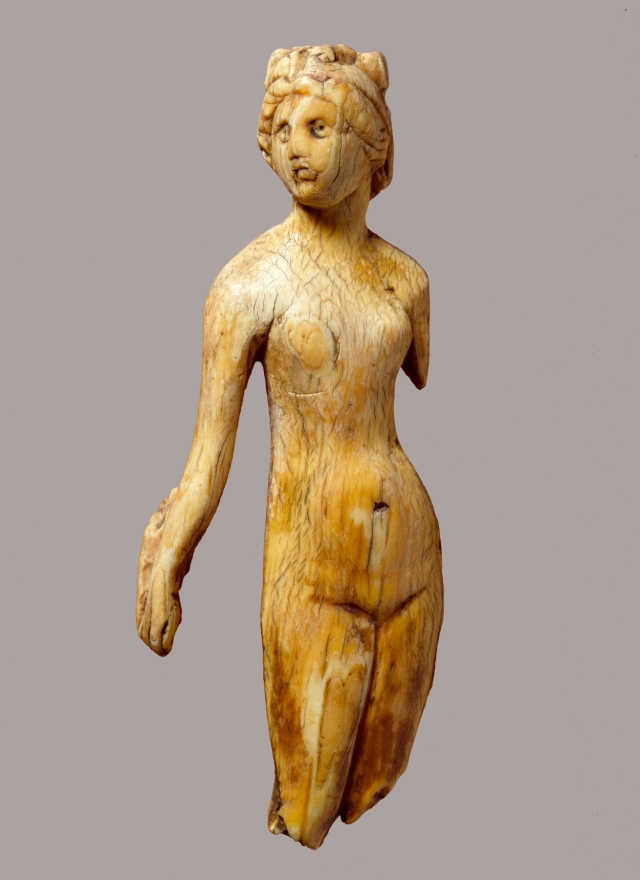 This earring is made from gold wire with pearls and sapphires. It is 6.1 cm by 2.4 cm by 1.2 cm. The weight of the earring is 12 grams. The earring is currently in the Metropolitan Museum of Art.
This earring is made from gold wire with pearls and sapphires. It is 6.1 cm by 2.4 cm by 1.2 cm. The weight of the earring is 12 grams. The earring is currently in the Metropolitan Museum of Art.
◊
 This earring is also made from gold wire with braided gold and pearls. The ring is 2.5 cm, with the earring itself being 8.3 cm by 3.1 cm overall with a thickness of 0.7 cm. It is currently in the Metropolitan Museum of Art.
This earring is also made from gold wire with braided gold and pearls. The ring is 2.5 cm, with the earring itself being 8.3 cm by 3.1 cm overall with a thickness of 0.7 cm. It is currently in the Metropolitan Museum of Art.
◊
 This gold earring was made using a technique called opus interrasile, or pierced openwork, with two peacocks used in the design. It is 5.5 cm by 4.9 cm with a thickness of 0.3 cm. It is currently in the Metropolitan Museum of Art.
This gold earring was made using a technique called opus interrasile, or pierced openwork, with two peacocks used in the design. It is 5.5 cm by 4.9 cm with a thickness of 0.3 cm. It is currently in the Metropolitan Museum of Art.
◊
 This necklace is gold, with gold pendants that have been made from a sheet that was also decorated with opus interrasile but with wire beading (granulation) too. Detail-
This necklace is gold, with gold pendants that have been made from a sheet that was also decorated with opus interrasile but with wire beading (granulation) too. Detail-  The pendants have been separated with gold tubes made from sheet gold with wire beading. The chain is 55 cm, the medallion pendants are 4.9 cm by 3.8 cm with a 0.7 cm thickness. The petal pendant is 4.7 cm by 2.6 cm with the same thickness. The tubes are 3.6 and 0.9 cm thick. The necklace is currently in the Metropolitan Museum of Art.
The pendants have been separated with gold tubes made from sheet gold with wire beading. The chain is 55 cm, the medallion pendants are 4.9 cm by 3.8 cm with a 0.7 cm thickness. The petal pendant is 4.7 cm by 2.6 cm with the same thickness. The tubes are 3.6 and 0.9 cm thick. The necklace is currently in the Metropolitan Museum of Art.
◊
 This bracelet has been made using opus interrasile, with ivy leaf scrolls. The bracelet is 17.8 cm around, 3.1 cm wide with a thickness of 0.5 cm. The bracelet is in the Metropolitan Museum of Art.
This bracelet has been made using opus interrasile, with ivy leaf scrolls. The bracelet is 17.8 cm around, 3.1 cm wide with a thickness of 0.5 cm. The bracelet is in the Metropolitan Museum of Art.
Recommended reading
The Met has publications covering Byzantine art & jewelry available for sale and download (in pdf format).
From Attila to Charlemagne: Arts of the Early Medieval Period in The Metropolitan Museum of Art edited by Brown, K.; Little, C. and Kidd, D. Publication available for download.
The Glory of Byzantium: Art and Culture of the Middle Byzantine Era, A.D. 843–1261 edited by Evans, H & Wixom, W. Publication available for download.
Byzantium and Islam: Age of Transition edited by Evans, H. Publication available for purchase.































